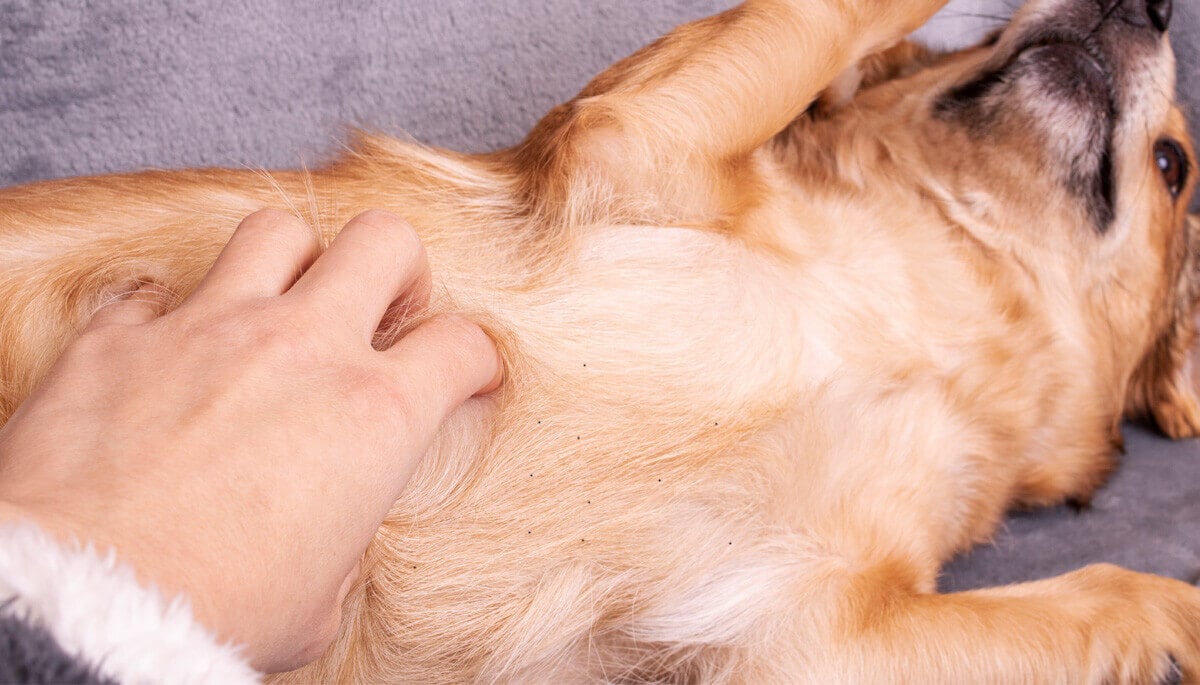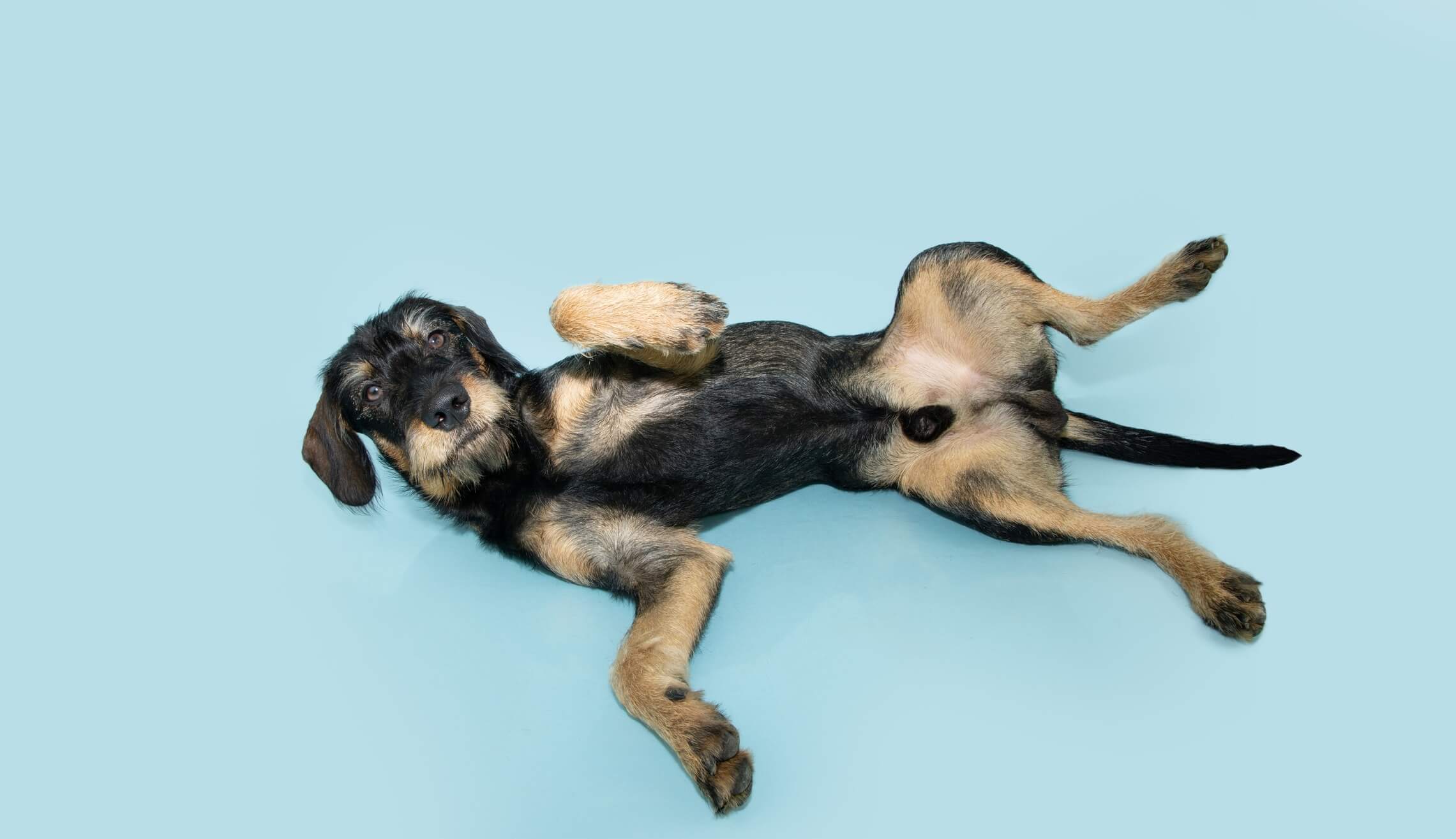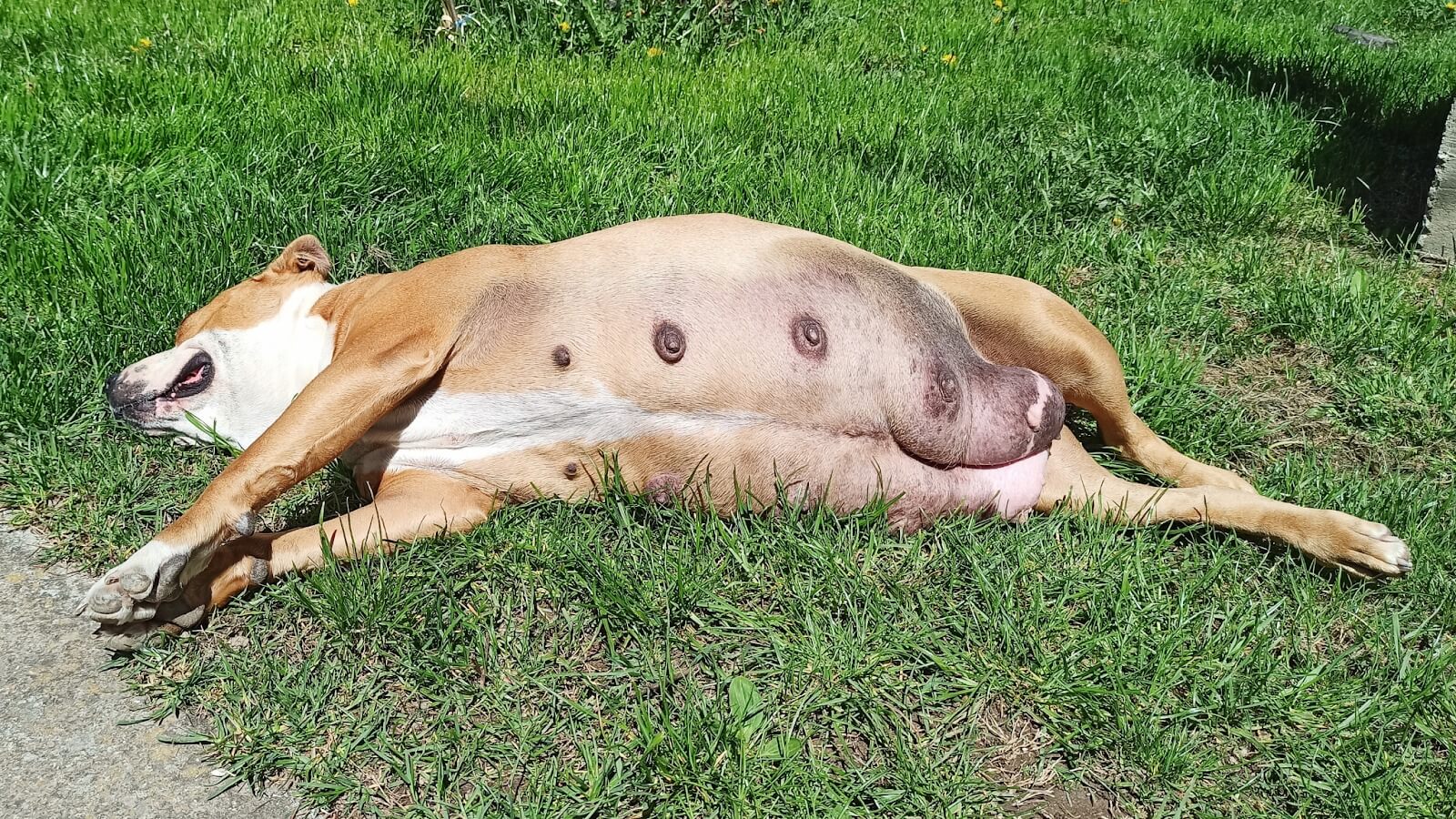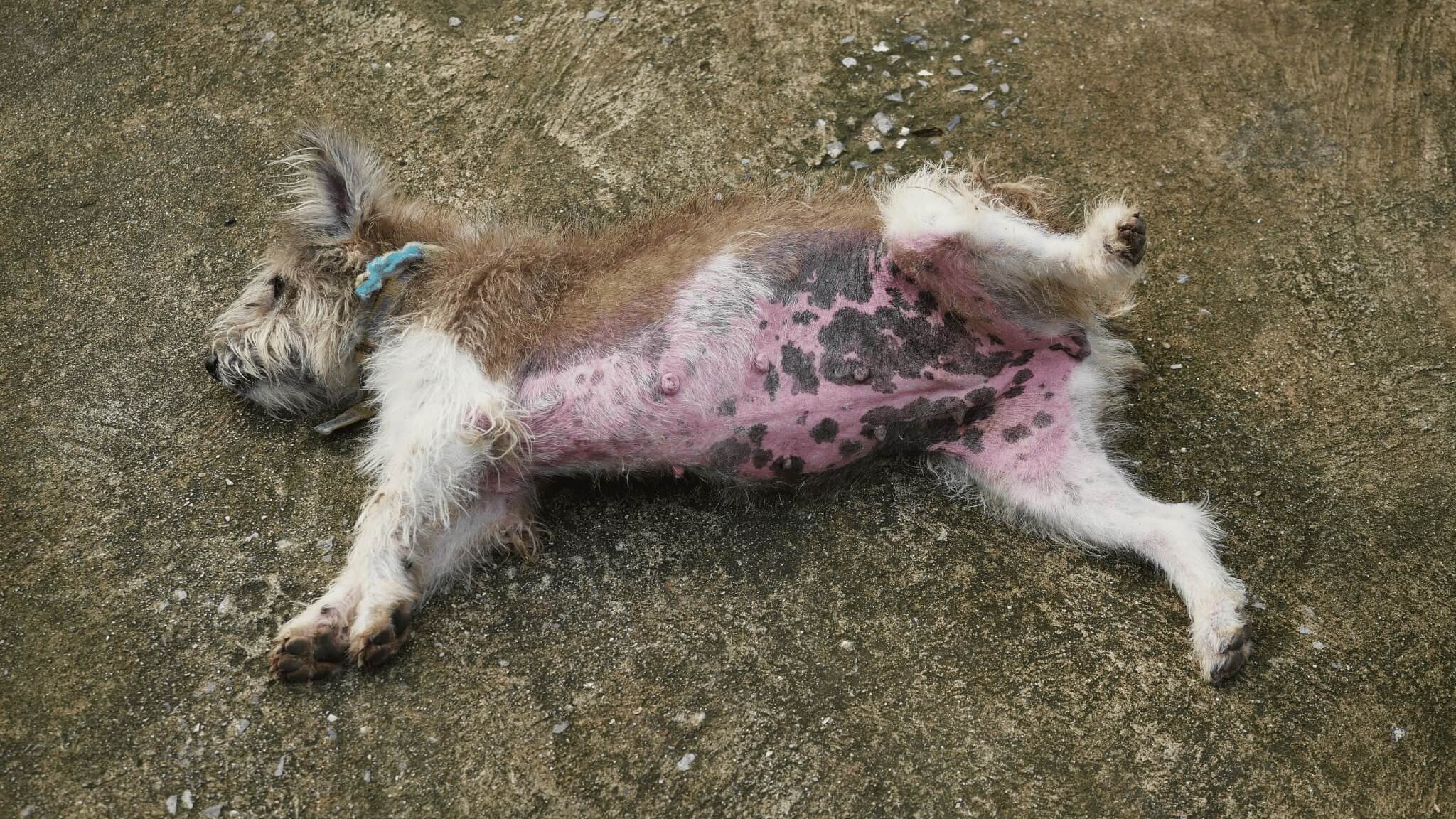Dog blackheads might give some flashbacks to high school and the horrors of problem skin. With canines, swollen pores with black or reddish-brown gunk can appear anywhere. It’s not uncommon to find blackheads on their back, neck, chest, and even nipples.
But dogs get blackheads for different reasons than humans do, and many of these reasons are actually a cause for concern. Of course, ensuring our dogs are properly groomed with a gentle dog wash is part of the solution (and prevention). This way, we keep excess grease from building up in their pores.
But to get into blackheads and what they mean, we’ve consulted the Clinical Atlas of Canine and Feline Dermatology to arrive at the root of the problem.
Why do dogs get blackheads?
Many dogs, especially certain purebreds, are prone to blackheads. They often result from mites, or seborrhea, where the skin produces too much keratin that clogs the pores. Serious conditions like Cushing’s disease, diabetes, and cancer can cause clogged pores.
So, if you’ve found dilated pores on your dog that are filled with black gunk, it most likely is a blackhead. However, clogged pores just a phase for adolescents the way they are for most humans. It often signals a bigger problem.
Read this article if your dog has also developed pimples or dog acne.
How do dogs get blackheads?
Before we get into the many possible causes, we need first to understand what blackheads, called comedones, really are.
Each dog hair follicle produces keratin for the hair and has a sebaceous gland, which produces sebum to moisturize the skin and coat. An excess of keratin and sebum can clog the pore.
Essentially, a dog’s pores become filled with the skin’s natural oils (sebum), keratin, dead skin cells, and other debris, as in the case of oily seborrhea.
However, a number of underlying problems can cause the skin to produce too much oil, creating blackheads. Sometimes the problems are genetic, but they can also happen from a mite infestation or certain types of cancer.
Warning! Canine blackheads are often not really blackheads
One point to note is that dog dermatology is complicated, and sometimes one disorder can look like another. Sometimes they overlap. For instance, if you are googling “blackhead on dog belly” or “blackhead on dogs privates,” the problem may actually be folliculitis.
This would be inflamed hair follicles from bacteria or perhaps yeast. It often affects a dog between the toes, the belly, the armpits, or the genitals. In turn, folliculitis is a sign of many other problems, usually related to various skin infections.
This is not the only example of potential confusion, but it is one to keep in mind if you spot a blackhead.
What causes canine blackheads?
The most common cause of clogged pores in dogs is a problem with keratin and sebum production, causing seborrhea. However, if you find blackheads on your dog, it’s essential to consider the many underlying conditions. Let’s review what causes blackheads.
1. Canine Acne
Dogs often develop comedones and papules on the chin area. See our articles on dog acne and folliculitis if your dog is developing clogged pores, bumps, or cysts on their facial or mostly chin area.
2. Primary Seborrhea & Genetic Problems
Certain breeds sometimes develop primary seborrhea that may cause blackheads. Seborrhea is caused by a fault in how the skin, claws, or hair follicles produce keratin. This causes scaliness or dandruff and sometimes makes the coat greasy, clogging the pores.
Primary seborrhea is not itchy but may become itchy if the dog gets a secondary yeast or bacterial infection.
Dog breeds most likely to get this are:
- Cocker Spaniels (American and English);
- English Spaniels;
- Bassets;
- West Highland White Terriers;
- Retrievers (Golden & Labradors); and
- German Shepherds.
Another type of inherited disorder is Schnauzer Comedone Syndrome. In these cases, Schnauzers have defective hair follicles, and small scabs or blackheads appear on their back and neck. It can also affect other rough-coated terriers like the Cairn Terrier or Scottish Terrier.
Seborrhea symptoms: Oily Seborrhea vs. Dry Seborrhea
One should also remember there is a difference between dry and oily seborrhea. Dogs with a greasy coat and bad smell, even after a bath, may have what’s called oily (oleosa) seborrhea. This means there is an overproduction of grease, and dogs with this problem have the most blackheads.
But in the case of dry seborrhea, the skin does not produce enough sebum. This means dandruff and scales from dry skin. It can also damage the natural water barrier of their skin, leading to secondary (usually itchy) skin infections like black scabs from pyoderma. Remember, secondary seborrhea often leads to yeast or bacterial infections.
Most dogs with seborrhea have both the oily and dry kind. So if you see blackheads, look for areas with dry skin that may need more moisture.
3. Secondary Seborrhea
One can only know if a dog has primary seborrhea by ruling out if they have the second kind. This is when the underlying condition disrupts the balance in the skin and causes pretty much the same symptoms. It may or may not be itchy.
So if dogs show signs of seborrhea, your veterinarian always needs to check for the following:
Hormonal imbalances
One of the major reasons middler-aged or senior dogs get blackheads is because of a hormonal problem. The major culprit is usually Cushing’s disease (hyperadrenocorticism) or hypothyroidism. One is a problem with the thyroid, and the other is with the adrenal gland. Another possibility is diabetes.
In these cases, you may also see hyperpigmentation or changes in the color and texture of the skin, like brown spots.
Allergies
In dogs younger than five, the common cause of blackheads from Seborrhea is allergies. A huge clue is a lot of itchiness and scratching, and you may see a lot of gunk in the ears, so check out our chart on ear discharge colors.
Demodex mite
After seborrhea, the second most common cause of blackheads in dogs are Demodex mites. These will usually be hairless patches filled with blackheads. Sometimes, they are itchy, but not always.
It can often look like acne because it can form pustules around the mouth area. Other signs include hair loss, crusts, and scabs. These mites live deep in the hair follicles and sebum glands, so an infection can definitely cause comedones. Be careful; it’s highly contagious.
Nutritional deficiencies
Nutrition plays a major role in skin health. Specifically, diets low in protein, B vitamins, zinc, and the omega-3 fatty acid, EPA, often cause skin issues like seborrhea.
Large, growing puppies are often deficient in zinc, as are Northern Breeds like Huskies, and may need supplements. Dogs also need enough vitamin E, A, pantothenic acid, pyridoxine, biotin, and vitamin A for a healthy coat.
However, these nutrients need to be properly balanced. Dogs eating unbalanced diets are at risk of more severe health problems.
Skin Lymphoma
Dogs with skin lymphoma may also get blackheads. Typically these can be any lesions, such as red patches, nodules, papules, ulcers, scales, or alopecia. This usually develops into a thick, red area with ulcers that may leak fluid.
Immune-system diseases
Immune system disorders such as pemphigus or lupus can also cause secondary seborrhea. It’s usually complicated, but many autoimmune diseases attack the integrity and health of the skin and coat.
Pressure sores (calluses) & Friction Blackheads
Another place you may find blackheads are on your dog’s elbows or hocks. These spots are usually where your dog (typically an older dog from a large breed) may be pressing on hard ground when lying down. This causes calluses to develop or hard spots that may have comedones or infected hair follicles.
A good paw balm can moisturize and soften these areas. But you may see blackheads on them because repeated friction damages the hair and irritates the hair follicle. This can cause them to become clogged.
Sometimes blackheads form under a dog’s armpits or groin area because of the rubbing and friction. It may also happen in dogs with skin folds.
Overuse of Medication
Dogs on certain medications for a long time, specifically oral steroids, often develop skin issues, including blackheads.
Growths & tumors
If the blackheads seem to be growing into lumps and bumps, then pet parents need to be concerned about tumors. One problem may be growths in the sebaceous glands called sebaceous adenoma. These can look a bit like skin tags.
If blackheads seem to grow, become raised or lumpy, have irregular coloring or develop into sores that won’t heal, speak to your vet immediately.
Obesity
Sadly, being overweight can also cause many skin issues in dogs, including blackheads. Obese dogs have more circulation issues and tend to have generally unhealthy skin. They are also more prone to issues like diabetes, which can cause secondary seborrhea and blackheads.
Chinese Crested Blackheads (comedones in hairless dogs)
It appears that blackheads and acne in hairless dogs such as Chinese Crested or the Xoloitzucuintlis are different from other dogs. It seems to be much more similar to human acne.
This is because it seems to be epidermal lipids, such as ceramides and fatty acids, behind skin issues. But in other dogs, blackheads are usually clogged hair follicles.
How do I get rid of blackheads on my dog?
If you see blackheads on your dog, the first thing to do is see a vet and start the process of elimination. If the blackheads are on the chin, part of the facial area, and part of a simple acne outbreak, they respond well to benzoyl peroxide cleanser.
However, if it’s not just facial acne, follow the following steps to address your dog’s skin problems.
Step 1: Do blood tests on your dog for underlying conditions such as Cushing’s, diabetes, lupus, or hypothyroidism.
Step 2: Have your vet rule out demodectic mange.
Step 3: Ask for ELISA testing and start testing for possible allergens. These could be in your dog’s environment, like pollen or food allergies.
Step 4: Ask your vet to examine your dog for any suspicious lumps or signs of cancer-related skin issues.
Step 5: Ask your vet about shampoos for flushing the follicles in oily seborrhea.
Step 6: bathe any hairless breed with a gentle shampoo and skin moisturizer every one-to-weeks to prevent oil build-up.
Step 7: Look to add fish oil supplements and aim for at least 20mg of EPA per pound of body weight daily. You can also increase vitamin E to about 300 IU per day. Speak to your vet about possible zinc supplements.
Step 8: Speak to your vet about retinoids and other topical treatments for seborrhea. Retinoids should help the skin purge comedones.
Can I pop my dog’s blackheads?
Never pop your dog’s blackheads. Not only does it spread bacteria, as with humans, but a dog’s skin has a much higher PH. This makes them extremely vulnerable to secondary bacterial and yeast infections when their skin breaks.
If your dog has mites, then popping the blackhead is a great way to spread this contagious parasite.
So how do you get rid of dog blackheads?
Dog blackheads removal:
Firstly, never try to remove the blackhead yourself. After your vet has treated any underlying problem, you can use the following to remove blackheads.
- If your dog has mild blackheads, gently scrub the area about once every two weeks to exfoliate it.
- You can apply a safe Benzoyl peroxide or ointment to the area. Speak to your vet about a salicylic acid (BHA) solution, but be careful as it is too strong and can damage your dog’s skin further and even cause a chemical burn. So do not use human acne or blackhead treatments from your own stash as they can have adverse effects on your dog.
- Be careful not to overwash or under wash your dog. Overwashing strips the coat of natural oils and creates dry skin problems. But not washing your dog enough can cause the oil to build up and clog pores.
Final Thoughts
Blackheads on dogs may seem a minor issue and nothing to worry about. Indeed, sometimes you can treat it along with dog acne if it’s on the face. But skin conditions in dogs often have an underlying cause that needs veterinary treatment.
If you spot blackheads on dogs, be sure to take your dog for a check up. Since problems like Cushing’s disease or even tumors can cause clogged pores, it’s best not to ignore them.









